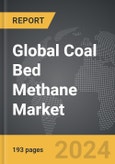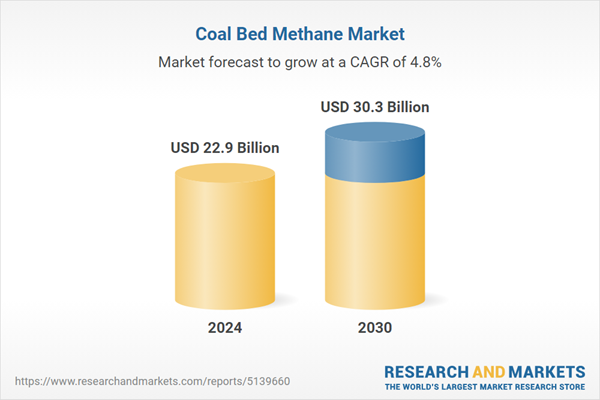Global Coal Bed Methane Market - Key Trends and Drivers Summarized
Why Is Coal Bed Methane an Important Energy Resource?
Coal Bed Methane (CBM), also known as coal seam gas, is becoming an increasingly important energy resource, but what makes it so significant? CBM is a form of natural gas extracted from coal beds, and it plays a crucial role in the global energy mix, particularly as the world seeks cleaner alternatives to traditional fossil fuels. Unlike conventional natural gas, which is trapped in underground reservoirs, CBM is adsorbed onto the surface of coal particles. This methane can be safely extracted and used as an energy source, making it a valuable byproduct of coal mining operations. As a cleaner-burning fuel, CBM emits significantly lower levels of carbon dioxide, sulfur, and nitrogen oxides compared to coal and oil, contributing to its appeal in countries seeking to reduce greenhouse gas emissions. It is used for electricity generation, residential heating, and as a feedstock for various industrial processes, providing a versatile energy option. Moreover, CBM development can help reduce the risks of methane emissions from abandoned or active coal mines, offering environmental benefits while harnessing an otherwise wasted resource.What Makes Coal Bed Methane Extraction So Specialized?
The extraction of Coal Bed Methane is highly specialized due to the unique geological conditions and technical challenges associated with coal seams. Unlike conventional natural gas deposits, where the gas is trapped in porous rock formations, CBM is contained within the matrix of the coal itself. This requires specialized drilling techniques to access the methane, typically through vertical or horizontal wells drilled directly into coal seams. One of the main challenges of CBM extraction is the need to reduce the water pressure in the coal seam to release the methane, as coal beds are often saturated with water. This process, known as dewatering, involves pumping out water from the coal bed to allow the methane to desorb from the coal and migrate into the well. The composition of the coal seam, including its permeability, thickness, and gas content, influences the success of CBM extraction, requiring advanced geological surveys and modeling to identify the most productive sites. Modern extraction techniques also involve hydraulic fracturing (fracking) in some cases, where the coal seam's permeability is artificially enhanced to increase methane flow. However, CBM extraction is less environmentally invasive than conventional fracking in shale gas operations, as coal seams are typically located at shallower depths and require lower pressures to fracture. Additionally, companies are employing innovations such as multi-lateral wells and real-time monitoring systems to optimize methane production while minimizing the environmental impact. The specialized nature of CBM extraction ensures that the process is efficient and safe, unlocking significant energy potential from previously underutilized coal deposits.How Is Coal Bed Methane Evolving as an Energy Resource?
The development and utilization of Coal Bed Methane are evolving rapidly, driven by advancements in extraction technology and a growing global interest in cleaner energy alternatives. One of the most notable trends is the increasing use of CBM in power generation, where it is being integrated into natural gas grids or used directly in power plants to generate electricity. This shift is particularly evident in countries like the United States, Australia, and China, where CBM resources are abundant and the infrastructure to harness this gas is expanding. In addition to power generation, CBM is being used as a feedstock for the production of chemicals and fertilizers, broadening its industrial applications. Moreover, advancements in drilling and reservoir management are making CBM extraction more efficient and cost-effective. Horizontal drilling, for example, allows for greater access to coal seams and improves methane recovery rates, while advancements in well design reduce the environmental footprint of extraction operations. Another significant development is the rise of carbon capture and storage (CCS) technologies that can be integrated with CBM operations. This enables methane to be extracted while simultaneously capturing and storing any excess carbon dioxide produced, further enhancing the environmental credentials of CBM. Additionally, the reuse of water extracted during CBM dewatering for agricultural or industrial purposes is emerging as a sustainable practice, reducing the environmental impact and making CBM projects more viable in water-scarce regions. As global energy demands shift toward more sustainable sources, CBM is positioning itself as a bridge between traditional fossil fuels and renewable energy, offering a cleaner, reliable alternative in the transition to a low-carbon future.What Is Driving the Growth of the Coal Bed Methane Market?
The growth in the Coal Bed Methane market is driven by several factors, closely linked to global energy trends, technological advancements, and changing environmental regulations. One of the primary drivers is the increasing demand for cleaner energy sources, particularly in regions that are looking to reduce their reliance on coal while maintaining energy security. As countries around the world implement stricter environmental policies, such as carbon emissions reduction targets under international agreements like the Paris Accord, CBM offers a practical solution for reducing greenhouse gas emissions without drastically overhauling existing energy infrastructures. CBM's lower carbon footprint compared to coal and oil makes it an attractive option for power generation and industrial use, especially in coal-dependent economies like China, India, and Australia. Technological advancements are another key driver of market growth. The development of more efficient drilling and dewatering techniques, coupled with innovations in methane recovery and well management, has significantly reduced the costs of CBM extraction, making it more competitive with conventional natural gas. The increasing integration of CBM into natural gas infrastructure, such as pipelines and storage facilities, is further driving market expansion. As more countries build the necessary infrastructure to transport and utilize CBM, its role in the global energy market is expected to grow. Additionally, government incentives and subsidies for cleaner energy projects are encouraging investments in CBM extraction, particularly in regions where coal mining is a significant industry. Lastly, the ability to repurpose dewatering byproducts for agricultural and industrial use is adding an economic and environmental edge to CBM projects, further fueling their growth in the global market. These combined factors are positioning Coal Bed Methane as a critical component of the future energy landscape, offering both environmental and economic benefits in the transition toward cleaner energy.Report Scope
The report analyzes the Coal Bed Methane market, presented in terms of market value (USD). The analysis covers the key segments and geographic regions outlined below.- Segments: End-Use (Industrial, Power Generation, Residential, Commercial, Transportation).
- Geographic Regions/Countries: World; United States; Canada; Japan; China; Europe (France; Germany; Italy; United Kingdom; Spain; Russia; and Rest of Europe); Asia-Pacific (Australia; India; South Korea; and Rest of Asia-Pacific); Latin America (Argentina; Brazil; Mexico; and Rest of Latin America); Middle East (Iran; Israel; Saudi Arabia; United Arab Emirates; and Rest of Middle East); and Africa.
Key Insights:
- Market Growth: Understand the significant growth trajectory of the Industrial End-Use segment, which is expected to reach US$11.5 Billion by 2030 with a CAGR of 4.7%. The Power Generation End-Use segment is also set to grow at 6.1% CAGR over the analysis period.
- Regional Analysis: Gain insights into the U.S. market, valued at $6 Billion in 2024, and China, forecasted to grow at an impressive 7.3% CAGR to reach $6.6 Billion by 2030. Discover growth trends in other key regions, including Japan, Canada, Germany, and the Asia-Pacific.
Why You Should Buy This Report:
- Detailed Market Analysis: Access a thorough analysis of the Global Coal Bed Methane Market, covering all major geographic regions and market segments.
- Competitive Insights: Get an overview of the competitive landscape, including the market presence of major players across different geographies.
- Future Trends and Drivers: Understand the key trends and drivers shaping the future of the Global Coal Bed Methane Market.
- Actionable Insights: Benefit from actionable insights that can help you identify new revenue opportunities and make strategic business decisions.
Key Questions Answered:
- How is the Global Coal Bed Methane Market expected to evolve by 2030?
- What are the main drivers and restraints affecting the market?
- Which market segments will grow the most over the forecast period?
- How will market shares for different regions and segments change by 2030?
- Who are the leading players in the market, and what are their prospects?
Report Features:
- Comprehensive Market Data: Independent analysis of annual sales and market forecasts in US$ Million from 2024 to 2030.
- In-Depth Regional Analysis: Detailed insights into key markets, including the U.S., China, Japan, Canada, Europe, Asia-Pacific, Latin America, Middle East, and Africa.
- Company Profiles: Coverage of players such as Arrow Energy Pty Ltd, Baker Hughes, Inc., Blue Energy Limited, BP PLC, ConocoPhillips Company and more.
- Complimentary Updates: Receive free report updates for one year to keep you informed of the latest market developments.
Some of the 44 companies featured in this Coal Bed Methane market report include:
- Arrow Energy Pty Ltd
- Baker Hughes, Inc.
- Blue Energy Limited
- BP PLC
- ConocoPhillips Company
- Encana Corporation
- Origin Energy Limited
- Santos Ltd.
- Shell International B.V.
This edition integrates the latest global trade and economic shifts into comprehensive market analysis. Key updates include:
- Tariff and Trade Impact: Insights into global tariff negotiations across 180+ countries, with analysis of supply chain turbulence, sourcing disruptions, and geographic realignment. Special focus on 2025 as a pivotal year for trade tensions, including updated perspectives on the Trump-era tariffs.
- Adjusted Forecasts and Analytics: Revised global and regional market forecasts through 2030, incorporating tariff effects, economic uncertainty, and structural changes in globalization. Includes historical analysis from 2015 to 2023.
- Strategic Market Dynamics: Evaluation of revised market prospects, regional outlooks, and key economic indicators such as population and urbanization trends.
- Innovation & Technology Trends: Latest developments in product and process innovation, emerging technologies, and key industry drivers shaping the competitive landscape.
- Competitive Intelligence: Updated global market share estimates for 2025, competitive positioning of major players (Strong/Active/Niche/Trivial), and refined focus on leading global brands and core players.
- Expert Insight & Commentary: Strategic analysis from economists, trade experts, and domain specialists to contextualize market shifts and identify emerging opportunities.
Table of Contents
Companies Mentioned (Partial List)
A selection of companies mentioned in this report includes, but is not limited to:
- Arrow Energy Pty Ltd
- Baker Hughes, Inc.
- Blue Energy Limited
- BP PLC
- ConocoPhillips Company
- Encana Corporation
- Origin Energy Limited
- Santos Ltd.
- Shell International B.V.
Table Information
| Report Attribute | Details |
|---|---|
| No. of Pages | 193 |
| Published | December 2025 |
| Forecast Period | 2024 - 2030 |
| Estimated Market Value ( USD | $ 22.9 Billion |
| Forecasted Market Value ( USD | $ 30.3 Billion |
| Compound Annual Growth Rate | 4.8% |
| Regions Covered | Global |









